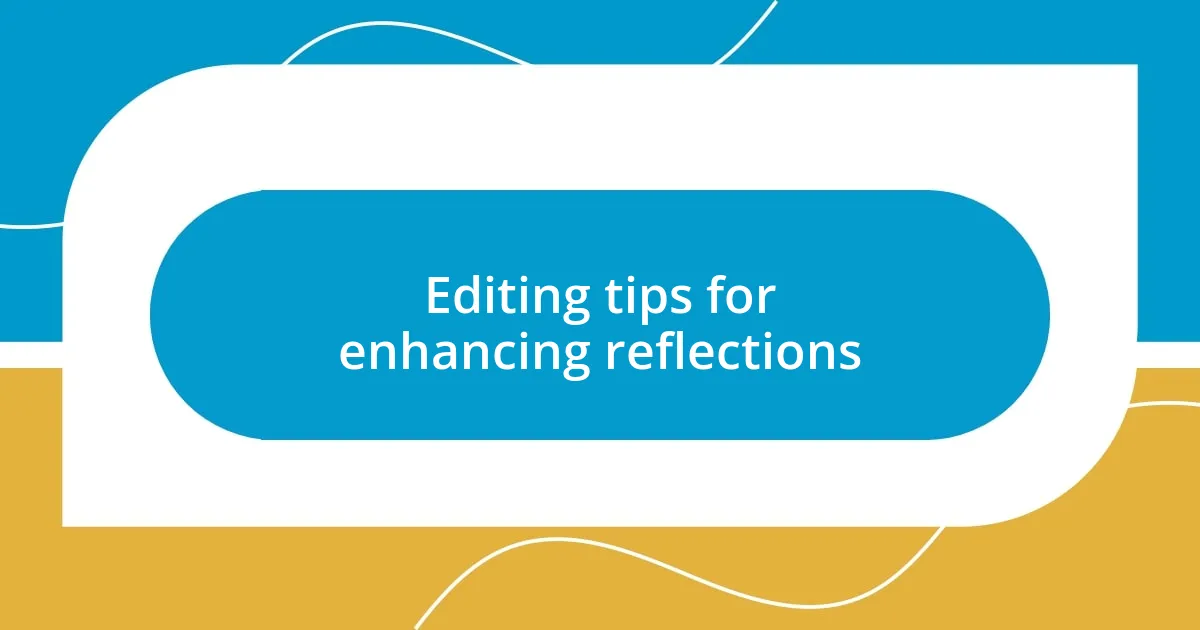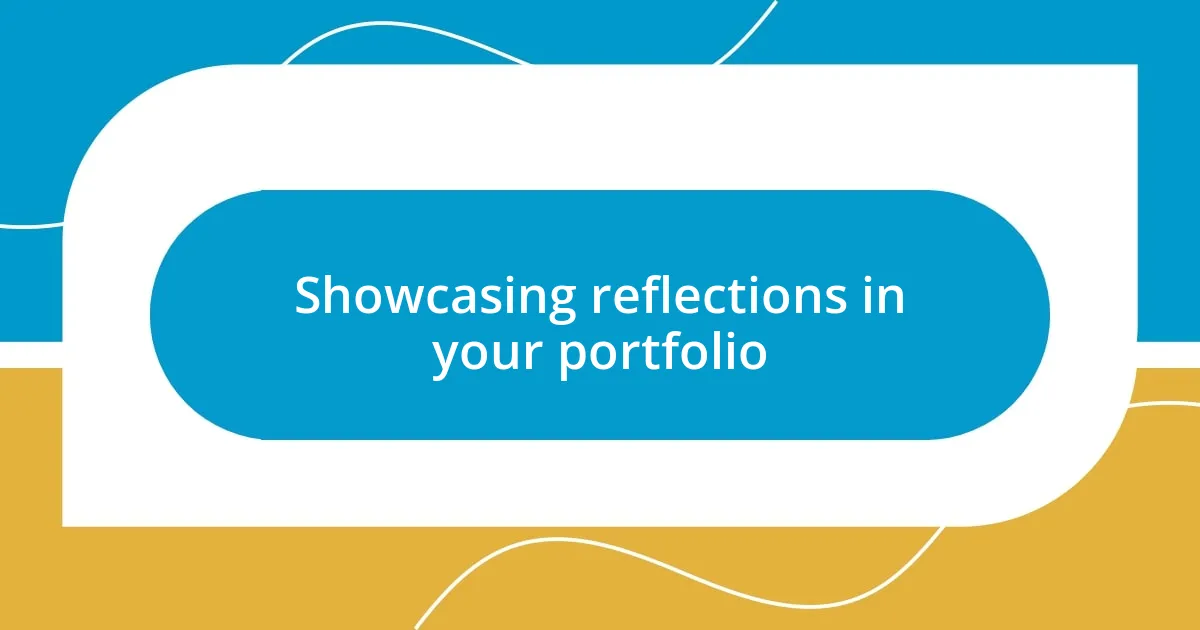Key takeaways:
- Reflections in water are best captured during dawn/dusk for soft, warm light; midday light can cause glare and shadows.
- Key camera settings include adjusting aperture for background softness, using appropriate shutter speed to freeze motion, and maintaining low ISO for clarity.
- Techniques like using a polarizing filter and positioning the camera low to the water’s edge enhance reflection clarity and emotional impact.
- Edit photos by adjusting contrast, cropping for composition, and applying sharpening with noise reduction to enhance visual quality.

Understanding reflections in water
Reflections in water captivate me in ways I never anticipated. The way light dances on the water’s surface, creating a mirror image, feels almost like witnessing a fleeting moment of magic. Have you ever found yourself lost in the tranquility of a lake, mesmerized by how the surrounding scenery merges seamlessly with its reflection?
This phenomenon occurs due to the properties of light and the smoothness of the water’s surface. When light hits the water, some bounces back, creating that stunning reflection. I remember one serene morning by a calm pond, the sky’s colors blended beautifully with the still water, which made me ponder—how often do we overlook such details in our everyday lives?
While capturing these reflections can be challenging, understanding the science behind them adds a layer of appreciation. I’ve found that early mornings or late afternoons provide the best lighting, making the reflections vibrant and clear. In those quiet moments, I often feel a deep connection to nature, reminding me of life’s simplicity and beauty.

Analyzing light conditions for reflections
Analyzing light conditions for reflections
When I step outside at dawn, the soft, golden light always leaves me in awe. It’s as if nature has painted the world in delicate brushstrokes. I’ve learned that the low angle of the sun at this hour enhances reflections, making them clearer and more defined. I can vividly recall a morning when I captured a breathtaking reflection of a mountain in a nearby lake, with the sunrise perfectly illuminating its surface. The stillness was surreal, and that moment ignited my passion for chasing these fleeting instances.
In contrast, when exploring at midday, the harsh sunlight often disrupts those perfect reflections. Instead of smooth mirrors, I’ve encountered blinding glare and sharp shadows. I remember one such day by a riverbank, where the glare obscured the beautiful scenery I wanted to capture. It illustrates how crucial it is to pay attention to light conditions and their effect on my photography.
Cloudy days, surprisingly, have their own magic. The diffused light softens the environment and allows for a different type of capture. I once enjoyed a rainy afternoon where the clouds draped the landscape in a muted palette, resulting in a stunningly serene photo that highlighted the gentle ripples in the water. It’s moments like these that remind me of the beauty in unpredictability.
| Time of Day | Effect on Reflections |
|---|---|
| Dawn/Dusk | Soft, warm light enhances clarity and vibrance. |
| Midday | Harsh light causes glare and harsh shadows, reducing quality. |
| Cloudy | Diffused light creates a gentle, serene mood with soft reflections. |

Choosing the right camera settings
When it comes to capturing reflections in water, selecting the right camera settings is crucial. I’ve often found that adjusting my aperture can dramatically alter outcomes. For instance, a wider aperture lets in more light, providing you with softer backgrounds, which is perfect for isolating reflections. On one occasion, I used an aperture of f/2.8, and the clarity of the reflection almost took my breath away; it felt intimate and special.
To achieve the best results, it’s essential to consider the following settings:
- Aperture (f-stop): Use a wider aperture (e.g., f/2.8 to f/5.6) for softer, more artistic backgrounds or a smaller aperture (e.g., f/8 to f/11) for a sharper focus throughout the entire image.
- Shutter Speed: A faster shutter speed will freeze motion, preventing ripples from disrupting the reflection, while a slower shutter speed can enhance the smoothness if wind or movement is minimal.
- ISO Sensitivity: Keep your ISO low (around 100-400) for bright conditions to minimize noise; adjusting it higher for lower light can help maintain clarity but watch for grain.
Experimenting with these settings has always brought me new delight, especially when I’m waiting for that perfect moment when everything aligns—the light, the water, and my camera adjustments. I recall a serene afternoon by a serene lake when I experimented with a slower shutter speed. The gentle movement of the trees in the water created a dreamy, impressionistic vibe. This moment taught me how personal adjustments can shape not just the image, but also the experience of capturing reflections.

Techniques for capturing still reflections
Capturing still reflections often requires a few key techniques to ensure you get that perfect shot. One of my favorites is using a polarizing filter. This clever tool reduces glare from the water’s surface, making reflections pop with clarity and depth. I remember a chilly autumn morning, the leaves a kaleidoscope of colors, when I adjusted the filter and gasped at the vibrant reflection of the trees in the lake—I felt as if I were looking at a painting brought to life.
Another technique I often rely on is getting low to the water’s edge. It surprises me how much of a difference this makes in capturing the full effect of the reflections. By positioning my camera just above the water, I eliminate distractions and focus solely on that stunning mirroring effect. I once knelt by a tranquil pond at sunset, and the reflection of the fiery orange sky enveloped me with an overwhelming sense of peace. The result was a shot that didn’t just capture a moment but conveyed a feeling—a memory that still warms my heart.
Timing also plays a significant role in reflection photography. I find that the moments just after rain or a light breeze can create magical opportunities. Water becomes a canvas, reflecting not just images but emotions too. There was this one instance during a light drizzle when I saw puddles forming on a path. The reflections were so clear that they showed me the surrounding trees’ intricate details, making me wonder what stories they would tell if they could speak. It’s amazing how nature can surprise us and transform what we think we know about capturing reflections.

Editing tips for enhancing reflections
Editing reflections can be a transformative process that elevates your images to new heights. When I edit my water reflections, I love experimenting with contrast and saturation adjustments. A slight increase in contrast can make the colors in the reflection pop, creating a more vibrant and engaging image. I vividly recall editing a photo of a sunset reflecting on a still lake; by enhancing the reds and oranges, it turned from a good shot into something that felt almost electric.
Another handy technique is to use cropping to refine the composition. I find that sometimes a reflection takes on a life of its own, drawing focus away from the main subject. By cropping in tighter on the reflection, you can create a captivating image that tells its own story. On one occasion, I cropped a shot of a mountain reflected in a lake, and it transformed a simple landscape into a mesmerizing focal point. Isn’t it fascinating how a small adjustment can drastically change a viewer’s perspective?
Finally, don’t underestimate the power of sharpening and noise reduction tools. Water can create beautiful textures, but sometimes the edits bring in unwanted noise, especially in low-light conditions. I often apply a bit of sharpening around the edges of my reflections to draw the eye, balancing it with noise reduction to keep the overall image smooth. I recall a particularly moody shot taken on a foggy morning; after careful editing, I preserved the ethereal quality of the scene while enhancing the reflection’s striking clarity. How do you feel when you see an enhanced reflection? For me, it resonates deeply—it’s like seeing the world through a clearer lens, both visually and emotionally.

Showcasing reflections in your portfolio
Showcasing reflections in your portfolio really can draw viewers into your world. I remember the first time I displayed a collection of my water reflection images. Each shot was a window into my emotional landscape, documenting not just beautiful visuals, but moments that sparked joy, contemplation, and serenity. When I received positive feedback about how the reflections conveyed a sense of calm, it confirmed the profound connection between what we capture and how we share it.
In creating a cohesive portfolio, I focus on variety while maintaining a thematic link through reflections. For instance, I once dedicated a series to different bodies of water at various times of day. Each image told a different story—a peaceful sunrise over a still pond contrasted with the vibrant hues of a sunset over an ocean. I often ask myself, what kind of atmosphere do I want to evoke? This question guides my selection process and ensures that each reflection not only represents my skills but also resonates with potential viewers.
I’ve learned that presentation matters just as much as content. When laying out my portfolio, I consider how each reflection complements the others. I try to balance colors, shapes, and moods across images. I was particularly proud when I received a compliment about the flow and harmony of my portfolio display at an exhibit. It felt like all my efforts coalesced into a tangible experience for the audience. How do your reflections connect with the viewers emotionally? For me, it’s all about inviting them to pause and immerse themselves in the stillness of water.














